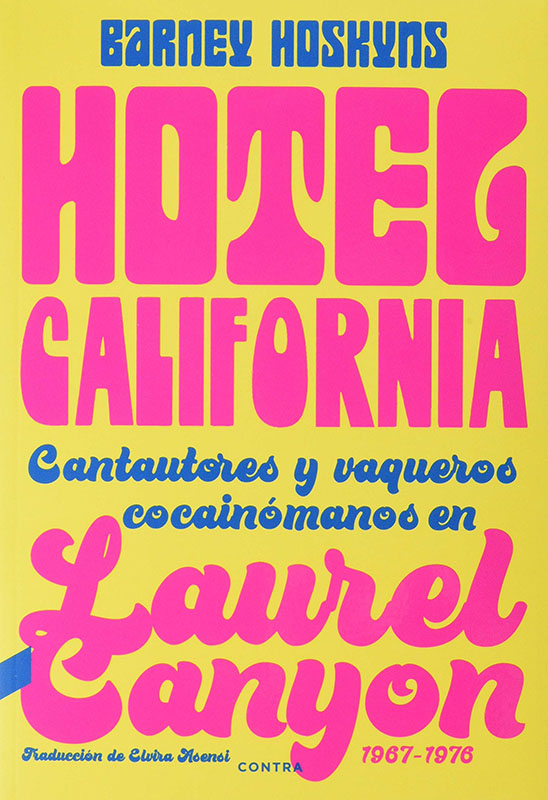Érase una vez un lugar bucólico, aunque quizá no tanto, donde una cantidad inusual de músicos con mucho talento y poco éxito, vivían felices, o infelices, dando forma a sus sueños. En este cuento que empieza en las colinas y desciende hasta las soleadas playas, el lobo una vez más se come a Caperucita. El lobo es la industria discográfica, sin necesidad de personificar en nadie, aunque David Geffen hace méritos suficientes para llevarse el dudoso galardón.
Hotel California: The True-Life Adventures of CSNY, Mitchell, Taylor, Browne, Ronstadt, Geffen, the Eagles, and Their Many Friends. BARNEY HOSKYNS
Once upon a time, there was an idyllic place, although perhaps not as idyllic as it could have been, where an unusual number of musicians with great talent and little success lived happily (or unhappily) ever after, making their dreams come true. In this fairytale, that starts out in the hills and takes us down to sunny beaches, the Big Bad Wolf will devour Little Red Riding Hood once more. This time, the Wolf is the recording industry, and although there’s no need to personify anyone, David Geffen has done his part to deserve such a dubious distinction.
Hoskyns incluso parece apiadarse de él en el epílogo. Es el eterno dilema, el maldito hijo de puta que hace que las cosas funcionen. ¿Habría existido sin su modo de llevar los negocios el estallido glorioso de música que se produjo en Los Ángeles en el decenio 1967-1976? Estamos hablando de tantos nombres que mencionarlos agotaría esta reseña, pero en una línea caben no solo los Eagles, sino Joni Mitchell, James Taylor, CSNY, Jackson Browne, Byrds, Linda Rondstadt y Ricky Lee Jones, y ahí me paro.
Hoskyns even seems to take pity on him in the epilogue. After all, we’re talking about the eternal dilemma: the son of a bitch who makes things work. Would the magnificent musical explosion that took place in Los Angeles from 1967-1976 have ever happened if he hadn’t done business his way? We’re talking about so many big names that listing them would just overload this article, but there’s at least enough room to mention not only the Eagles, but also Joni Mitchell, James Taylor, Crosby, Stills, Nash, Young, Jackson Browne, the Byrds, Linda Rondstadt and Ricky Lee Jones,… and I’ll stop there.
Barney Hoskyns parece haber hablado con todos y, cuando no lo ha conseguido con alguien, lo suple con suficientes testimonios indirectos como para que no importe. Con todo eso consigue lo que parecería imposible, hilar una historia, en la que además se detiene en los detalles de tal modo que da la impresión de que él estaba realmente allí: en las piscinas en las que se bañaban preciosidades con o sin nombre, en el porche en el que los canutos pasaban de mano en mano, al pie de la escena en el Trobadour o en el Roxy, en los despachos donde se hacían los negocios.
Barney Hoskyns seems to have talked to everyone, and when he wasn’t able to reach them directly, he makes do with enough indirect testimonies that it doesn’t make a difference whose account it is. He has accomplished something that seemed impossible to do. He has spun a story and lingers on the details in such a way that it gives the impression that he had actually been there, himself: in the pools where anonymous and not-so-anonymous beauties bathed, on the porches where blunts were passed from one hand to the next, in the thick of it all at the Trobadour or the Roxy, in the offices where all the deals were made…
Un auténtico aluvión de datos se diluye en la atmósfera poblada de anécdotas que tienen rango de hechos, que no mueven el motor de la historia de la música pero explican la idiosincrasia de sus protagonistas. Son esos seres fantásticos y distantes de los que seguimos el camino de su madurez artística, pero también los que llevan al cinismo autocomplaciente, a la perseverancia en la inmadurez personal o a las simas de la autodestrucción. De todo eso solo podía salir música maravillosa, la que da sentido a estas páginas publicadas en 2005 y que ahora llegan a nosotros traducidas al español.
An authentic barrage of information has been spewed out, peppered with anecdotes backed up by facts, which, while not truly the backbone of the history of music, do explain the idiosyncrasies of some of its leading men and women – the fantastic and distant beings whose paths of artistic maturity we follow so closely. Nevertheless, they also lead us to self-indulgent cynicism, to perseverance in personal immaturity or to the depths of self-destruction. Nothing other than amazing music could ever come from all this, and it is this music that gives meaning to these pages that were initially published in 2005 and that have now been finally translated into Spanish.
Texto por Juan J. Vicedo desde Libros para el camino. Lugar que tiene que ver con la música, y con lo que nos conmueve de la música.
Original text in Spanish written by Juan J. Vicedo from the podcast Libros para el camino.
Translation by Jessica Jacobsen.

